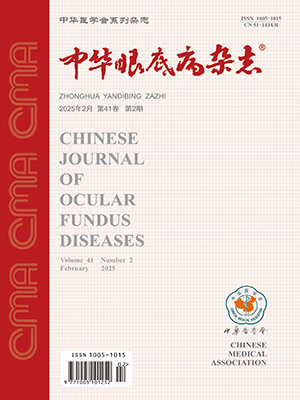| 1. |
Hartong DT, Berson EL, Dryja TP. Retinitis pigmentosa[J]. Lancet, 2006, 368(9549): 1795-1809. DOI: 10.1016/S0140-6736(06)69740-7.
|
| 2. |
彭大伟, 吴乐正, 周文炳. 视网膜色素变性合并青光眼32例临床分析[J]. 中华眼科杂志, 1991, 27(5): 262-264.Peng DW, Wu LZ, Zhou WB. Clinical analysis of 32 cases of retinitis pigmentosa complicated with glaucoma[J]. Chin J Ophthalmol, 1991, 27(5): 262-264.
|
| 3. |
Mathijssen IB, Florijn RJ, van den Born LI, et al. Long-term follow-up of patients with retinitis pigmentosa type 12 caused by CRB1 mutations: a severe phenotype with considerable interindividual variability[J]. Retina, 2017, 37(1): 161-172. DOI: 10.1097/IAE.0000000000001127.
|
| 4. |
中华医学会眼科学分会青光眼学组. 我国原发性青光眼诊断和治疗专家共识(2014年)[J]. 中华眼科杂志, 2014, 50(5): 382-383. DOI: 10.3760/cma.j.issn.0412-4081.2014.05.022.Glaucoma Group, Ophthalmology Branch of Chinese Medical Association. Expert consensus on the diagnosis and treatment of primary glaucoma in China(2014)[J]. Chin J Ophthalmol, 2014, 50(5): 382-383. DOI: 10.3760/cma.j.issn.0412-4081.2014.05.022.
|
| 5. |
Grunwald JE, Maguire AM, Dupont J. Retinal hemodynamics in retinitis pigmentosa[J]. Am J Ophthalmol, 1996, 122(4): 502-508. DOI: 10.1016/S0002-9394(14)72109-9.
|
| 6. |
Sposato V, Iovieno A, Sornelli F, et al. Axonal transport deficit in the optic nerve of rats with inherited retinitis pigmentosa and experimentally induced glaucoma[J]. Graefe's Arch Clin Exp Ophthalmol, 2008, 246(11): 1553-1558. DOI: 10.1007/s00417-008-0903-7.
|
| 7. |
Peng T, Wu L, Zhou W. Retinitis pigmentosa associated with glaucoma--clinical analysis[J]. Yan Ke Xue Bao, 1990, 6(1-2): 17-19.
|
| 8. |
Ko Y, Liu C, Hwang D, et al. Increased risk of acute angle closure in retinitis pigmentosa: a population-based case-control study[J/OL]. PLoS One, 2014, 9(9): e107660[2014-09-15]. https://pubmed.ncbi.nlm.nih.gov/25222486/. DOI: 10.1371/journal.pone.0107660.
|
| 9. |
Song P, Wang J, Bucan K, et al. National and subnational prevalence and burden of glaucoma in China: a systematic analysis[J/OL]. J Glob Health, 2017, 7(2): 020705[2017-12-07]. https://pubmed.ncbi.nlm.nih.gov/29302324/. DOI: 10.7189/jogh.07.020705.
|
| 10. |
吕仲平, 陈晓明. 华西医院青光眼住院患者构成及其变化[J]. 国际眼科杂志, 2011, 11(11): 1953-1956. DOI: 10.3969/j.issn.1672-5123.2011.11.025.Lv ZP, Chen XM. Proportion and its changes of hospitalized patients with glaucoma in West China Hospital[J]. Int J Ophthalmol, 2011, 11(11): 1953-1956. DOI: 10.3969/j.issn.1672-5123.2011.11.025.
|
| 11. |
Cheng JW, Zong Y, Zeng YY, et al. The prevalence of primary angle closure glaucoma in adult Asians: a systematic review and meta-analysis[J/OL]. PLoS One, 2014, 9(7): e103222[2014-07-24]. https://doi.org/10.1371/journal.pone.0103222. DOI: 10.1371/journal.pone.0103222.
|
| 12. |
游玉霞, 李建军, 徐亮, 等. 合并视网膜色素变性的青光眼临床特征[J]. 眼科, 2013, 22(1): 42-44.You YX, Li JJ, Xu L, et al. Clinical characteristics of glaucoma associated with retinitis pigmentosa[J]. Ophthalmol CHN, 2013, 22(1): 42-44.
|
| 13. |
吴志鸿, 柳川, 余伟群, 等. 扇形视网膜色素变性合并急性闭角型青光眼一例[J]. 中华眼科杂志, 2010, 46(3): 277-278. DOI: 10.3760/cma.j.issn.0412-4081.2010.03.019.Wu ZH, Liu C, Yu WQ, et al. A case of fan-shaped retinitis pigmentosa complicated with acute angle closure glaucoma[J]. Chin J Ophthalmol, 2010, 46(3): 277-278. DOI: 10.3760/cma.j.issn.0412-4081.2010.03.019.
|
| 14. |
Gartner S, Schlossman A. Retinitis pigmentosa associated by glaucoma[J]. Am J Ophthalmol, 1949, 32(10): 1337-1350. DOI: 10.1016/S0002-9394(49)91752-3.
|
| 15. |
Zhang X, Wang W, Aung T, et al. Choroidal physiology and primary angle closure disease[J]. Surv Ophthalmol, 2015, 60(6): 547-556. DOI: 10.1016/j.survophthal.2015.06.005.
|
| 16. |
董莹, 黄一飞. 黏多糖贮积症的眼部表现[J]. 中国实用眼科杂志, 2011, 29(12): 1222-1225. DOI: 10.3760/cma.j.issn.1006-4443.2011.12.004.Dong Y, Huang YF. The ocular manifestation of mucopolysaccharide storage disease[J]. Chin J Pract Ophthalmol, 2011, 29(12): 1222-1225. DOI: 10.3760/cma.j.issn.1006-4443.2011.12.004.
|
| 17. |
Quigley HA, Maumenee AE, Stark WJ. Acute glaucoma in systemic mucopolysaccharidosis I-S[J]. Am J Ophthalmol, 1975, 80(1): 70-72. DOI: 10.1016/0002-9394(75)90871-5.
|
| 18. |
Fishman GA, Anderson RJ, Lourenco P. Prevalence of posterior subcapsular lens opacities in patients with retinitis pigmentosa[J]. Br J Ophthalmol, 1985, 69(4): 263-266. DOI: 10.1136/bjo.69.4.263.
|
| 19. |
Dikopf MS, Chow CC, Mieler WF, et al. Cataract extraction outcomes and the prevalence of zonular insufficiency in retinitis pigmentosa[J]. Am J Ophthalmol, 2013, 156(1): 82-88. DOI: 10.1016/j.ajo.2013.02.002.
|
| 20. |
Sudhir RR, Rao SK. Capsulorhexis phimosis in retinitis pigmentosa despite capsular tension ring implantation[J]. J Cataract Refract Surg, 2001, 27(10): 1691-1694. DOI: 10.1016/S0886-3350(01)00869-0.
|
| 21. |
Lee HJ, Min S, Kim TY. Bilateral spontaneous dislocation of intraocular lenses within the capsular bag in a retinitis pigmentosa patient[J]. Korean J Ophthalmol, 2004, 18(1): 52-57. DOI: 10.3341/kjo.2004.18.1.52.
|
| 22. |
Smith M, Pappas G, Evans N. Intraocular lens migration following posterior capsulotomy in retinitis pigmentosa[J]. Eye (Lond), 2007, 21(6): 867-869. DOI: 10.1038/sj.eye.6702739.
|
| 23. |
Hayashi K, Hayashi H, Matsuo K, et al. Anterior capsule contraction and intraocular lens dislocation after implant surgery in eyes with retinitis pigmentosa[J]. Ophthalmology, 1998, 105(7): 1239-1243. DOI: 10.1016/S0161-6420(98)97028-2.
|
| 24. |
Najjar DM, Igbre AO, Tsai FF. Late capsular bag contraction and intraocular lens subluxation in retinitis pigmentosa: a case report[J/OL]. J Med Case Rep, 2011, 5: 65[2011-02-14]. https://pubmed.ncbi.nlm.nih.gov/21320335/. DOI: 10.1186/1752-1947-5-65.
|
| 25. |
Gramer G, Gramer E. Stage of visual field loss and age at diagnosis in 1988 patients with different glaucomas: implications for glaucoma screening and driving ability[J]. Int Ophthalmol, 2018, 38(2): 429-441. DOI: 10.1007/s10792-017-0477-7.
|




